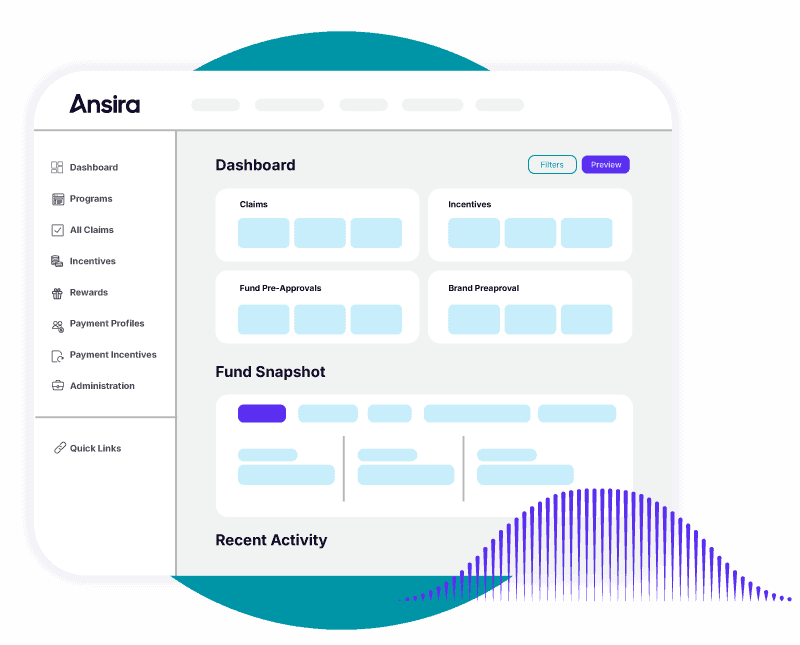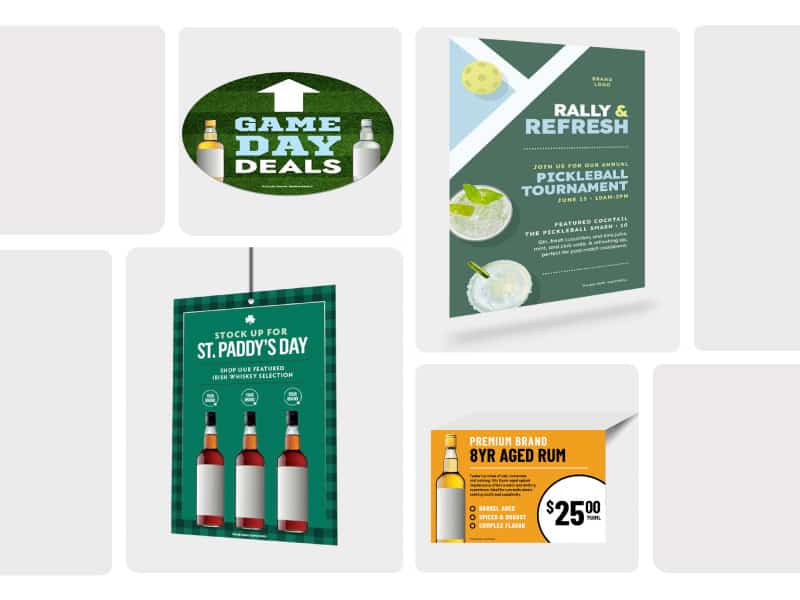The wine market is booming, with an estimated market size of 515.1 billion and an 8.1% growth rate projected over the next five years. But with over 11,000 wineries in the United States alone, this industry is highly saturated, and competition is fierce.
Break through the noise and maximize sales with high-impact wine marketing ideas that convert. Learn everything you need to know about creating a robust wine marketing strategy that moves the needle.
The essentials of wine marketing
Wine marketing is when a beverage alcohol supplier, distributor, or retailer strategically promotes its wine products with the goal of attracting customers and boosting sales.
There are three main components involved in marketing wine:
- Brand-building: It’s important to promote your products in a way that’s true to your brand identity to generate brand awareness and build trust.
- Storytelling: Your wine marketing should tell a clear story to convey your brand’s message in a way that resonates with your target audience while positioning your product as the answer to their problems.
- Strategic promotion: Every wine marketing strategy should cover a diverse range of channels, such as email, print, social media, and paid ads.
Why you need a strong wine marketing strategy
The wine market is highly saturated, meaning this industry isn’t an easy one to break into. To gain market share in a competitive landscape, you need a robust wine marketing strategy to put your brand top of mind for consumers.
When marketing wine with an impactful strategy, you’ll achieve:
- Increased brand awareness: The better your strategy, the more brand visibility and recall you create. As a result, your brand stands out in a crowded market.
- Greater market share: The more your brand attracts and converts customers, the more market share you’ll capture.
- More effective targeting: With a data-driven wine marketing strategy, you can target your ideal customer base more effectively and drive more conversions.
- Improved brand image: Your campaigns should represent your brand as a credible and trustworthy leader in your industry, creating positive associations that boost your reputation.
- Improved loyalty and trust: The better your brand is portrayed in your marketing, the more trust you build among consumers.
- Increased sales and ROI: With a high-impact wine marketing strategy, you’ll boost product sales and achieve a higher ROI for your brand.
How to craft a winning wine marketing strategy
You can’t create marketing campaigns without a little bit of forethought. That’s why you need to plan your strategy before you can start executing on your marketing.
Here’s how to build a wine marketing strategy that moves the needle.
1. Determine your goals
The first step of creating your strategy is defining your brand goals — in other words, determining what you want to achieve through your marketing.
Think about your main objective: Do you want to boost brand awareness? Diversify your customer base? Increase web traffic? Whatever your intention, your strategy should be in alignment to ensure your campaigns and tactics reflect the end goal.
2. Determine your target audience
When you market to everyone, you’re marketing to no one. That’s why you need to pinpoint your target audience and focus your marketing efforts on messaging and tactics that resonate most with that customer group.
Think about the characteristics that define your target audience. This should include demographic data like gender, age, income level, and geographic location, as well as psychographic information like purchasing behaviors, values, and interests. By evaluating these areas, you should be able to create a clear picture of your ideal customer profile (ICP). With this snapshot, you can create buyer personas to help your distributors or retailers better understand your target audience. As a result, they’ll be able to market to this group more effectively.
3. Choose the right marketing mix
Now that you know your business goals and audience, you can begin identifying the marketing channels you’d like to utilize in your campaigns. It’s vital to leverage a diverse range of channels to ensure you reach consumers where they are and leave no stone unturned. That means utilizing a combination of digital, traditional, and in-person tactics while ensuring alignment with the channels your ICP is using.
For example, if you’re marketing to a Gen Z audience on social media, you’re more likely to get through to them by promoting your products on Instagram than on Facebook, as platform usage for consumers aged 18 to 29 is 76% and 68%, respectively. However, the opposite would be true of a Gen X audience — 70% of adults aged 50 to 64 use Facebook compared to only 36% for Instagram.

4. Measure performance
Once your campaigns are up and running, it’s vital to track their performance to see what’s working, what’s not, and whether you need to pivot your strategy.
The first step to performance measurement is establishing key performance indicators (KPIs). By measuring your results against KPIs, you’ll be able to accurately evaluate the effectiveness of your marketing efforts.
Not sure which metrics to measure? Here are some KPIs to consider:
- Revenue growth
- Engagement
- Repeat purchases
- Event ROI
- Site traffic
- Sales volume
- Social media metrics (followers, likes, comments, shares)
- Email metrics (opens, click-through rate, conversions)
5. Optimize and refine
As you track your campaigns, be sure to dive into your performance metrics to inform your wine marketing strategy moving forward.

For example, if you notice that your campaigns aren’t performing as well as intended, you might want to reevaluate your strategy and make adjustments as needed. On the other hand, if one channel or tactic is performing significantly better than the others, you may want to reallocate your resources toward that high-performing tactic.
By making data-driven marketing decisions based on real-time campaign insights, you’ll be able to better optimize your wine marketing.
Wine marketing ideas to make your brand stand out
When it comes to your wine marketing, the sky’s the limit. With countless marketing tactics at your disposal, it can be challenging to choose the right ones for your brand. But with these 10 high-impact channels, you can take your wine marketing strategy to the next level.
1. Social media
A staggering 5.42 billion people are on social media — that’s 65.7% of the world population. So, for suppliers and distributors trying to capture customer attention, social media marketing is a no-brainer.
Social platforms are excellent for driving awareness, generating engagement, and building trust among your community. They also offer lots of visual real estate, allowing you to showcase your wine products in a way that catches the eye.
Here are some social media wine marketing strategies that are sure to make a splash:
- Engage with users: Connect with members of your community by regularly engaging with your followers by liking and responding to comments, mentions, and direct messages.
- Run contests: Organizing digital contests is a great way to boost awareness for your brand while racking up major engagement. They can even help you increase your follower count.
- Post visual content: Share visually engaging content like photos and videos of your wine products, vineyards, winemaking processes, and events to create a memorable image of your brand.
- Share user-generated content: User-generated content (USG) is an excellent form of social proof. Encourage your customers to post about your wine products and share these posts on your account to build trust and influence followers to purchase your products.
- Partner with influencers: Team up with influencers to tap into an already-engaged audience that’s interested in what you’re selling.
2. Paid media
You can take your marketing a step further by putting dollars behind it. Paid media helps brands reach consumers at every stage of the buyer’s journey with precise targeting. Plus, paid efforts are highly measurable, enabling you to track performance and gain insight into how your ads are performing.
Consider the following paid tactics for your wine digital marketing:
- Paid social: Paid social media allows you to create targeted ads in engaging visual formats, such as image, video, and carousel ads, allowing you to easily show off your wine products in an eye-catching way.
- Paid search: Pay-per-click is a fast-acting strategy that allows you to bid on relevant keywords (Ex. Best red wine) in exchange for a top spot in the search engine results pages, putting your ads front and center for high-intent consumers.
- Geotargeting: Geotargeting uses consumers’ mobile IP addresses to send them ads tailored to their locations and interests. For example, if you just came out with a new Riesling, you might target customers near your locations who regularly search for dry wines.
Let’s be clear: paid media isn’t an alternative to organic. With a combination of paid and organic marketing efforts, you can get wine bottles flying off the shelves.
3. Community involvement
Supporting local causes is a great way to drive awareness for your brand while generating trust and driving sales. You can build meaningful relationships with your community by sponsoring events, donating to local charities, or holding fundraisers.
You can also run cross-promotions with local businesses to create positive associations while tapping into their existing customer bases. For example, you might partner with a local chocolate artisan, showing that your wine and their chocolates make for the perfect Mother’s Day gift.
4. Email marketing
Email may seem old-school, but this tried-and-true tactic is vital for nurturing existing customers and engaging new ones. With strong subject lines, segmentation, and the power of personalization, you can drive more clicks and conversions.
Here are a few ideas for your wine email marketing strategy:
- Product promotions: Promote new products, sales, and deals to drive more foot traffic to your locations.
- Content curation: Share educational content that consumers may take value from, such as blogs, guides, and industry highlights.
- Welcome flows: Create an email flow that introduces new subscribers to your brand, establishes credibility, and encourages conversions through continuous nurturing.
- Abandoned cart: Abandoned cart emails are great for reminding customers about products they were interested in and motivating them to complete their transactions.
- Company updates: Keep your subscribers updated on company milestones, upcoming events, and other timely developments.
5. Experiential marketing
Make your wine marketing an experience. With experiential marketing tactics, you can create memorable experiences that leave a lasting impression on consumers.
Types of experiential marketing tactics you can leverage for your wine brand include:
- Winery tours
- Wine tastings
- Pop-ups
- Events
- Immersive workshops
6. Sustainability initiatives
Today, customers care more than ever about environmental responsibility and actively seek out brands with the same values. So, if your brand leverages any ingredients, processes, or products that prioritize sustainability, it’s time to make it known.
Examples of sustainable practices you can publicize include:
- Recycled packaging
- Organic ingredients
- Vegan options
- Renewable energy use
- Responsible water management
- Natural pesticide use
- Focus on soil health
7. E-commerce site optimization
If you sell your wine products online, it’s crucial that your e-commerce site is optimized to offer a seamless shopping experience. Otherwise, consumers won’t bother jumping through hoops to get to checkout — and will likely turn to a competitor whose site has greater ease of use.
Don’t miss out on sales because of your site. To ensure a smooth and user-friendly e-commerce experience, prioritize the following components of your digital store:
- Fast load speed
- Mobile friendliness
- Data security
- Clear navigation
- Visual appeal
- Branding consistency
- Complete product descriptions
When your e-commerce site is optimized to provide a positive user experience, customers are more likely to make purchases.
8. Loyalty programs
Want to cultivate customer loyalty while driving more sales? Loyalty programs are an effective addition to any wine marketing strategy. By offering these memberships, you provide your customers with more value with every purchase, resulting in greater customer satisfaction and retention. Plus, if your customers like your loyalty program, they’ll spread the word and recruit more customers.
There are various structures your wine loyalty program can take:
- Tiered: Rewards are organized into tiers that can be achieved by spending certain amounts of money, with better rewards offered at higher tiers. For example, customers could earn a buy-one-get-one-half-off discount at the silver tier and get a free bottle of wine at the gold tier.
- Points-based: Through points-based programs, customers can earn points with every purchase and eventually exchange them for rewards, such as discounts or free wines.
- Subscription: In a subscription program, members pay a recurring fee to gain access to exclusive benefits. For example, members may get early access to new product releases, discounted tickets to events, or exclusive wines.
Remember, loyalty programs can reward more than just transactions — you can always give customers benefits for other forms of engagement, like leaving reviews, subscribing to your newsletter, or engaging with your social media accounts.
9. Content marketing
You can build authority for your brand while providing value to customers by producing helpful and engaging content like blogs, videos, and infographics. By writing relevant thought leadership, you can position your brand as an industry leader while gaining trust from your target audience.
Here are some content ideas you can run with:
- Wine-pairing tips
- Virtual vineyard tours
- Guide to different wine varieties
- Wines around the world
- How to develop your wine palate
- Guide to seasonal wines
- Identifying wine by taste and aroma
Be sure to create your marketing content with search engine optimization (SEO) in mind to get the most traffic to your website.
10. Point-of-sale materials
If your wines are available in-store, you know yours isn’t the only brand customers have to choose from. Make your products stand out from the competition with eye-catching point-of-sale (POS) displays. These printed marketing materials are positioned at the point of sale — in the checkout line or by the cash register — and promote products with visually appealing imagery that catches shoppers’ attention.

POS displays are great for making your products pop, generating impulse purchases, and upselling products.
Some of the many types of point-of-sale materials you can choose for your wine marketing include:
- Posters
- Banners
- Floor graphics
- Shelf talkers
- Ceiling danglers
- Countertop displays
- Dump bins
- Free-standing display units
Get expert wine marketing support with Ansira
When it comes to your wine marketing strategy, you need an effective mix of digital and traditional tactics to make your brand stand out from the competition in a saturated market.
Work with a marketing partner that specializes in the beverage alcohol industry. At Ansira, we’ve been helping brands achieve channel marketing success for over 100 years.
Book a demo with one of our experts to see why our distributed growth platform is trusted by some of the biggest names in the industry.




